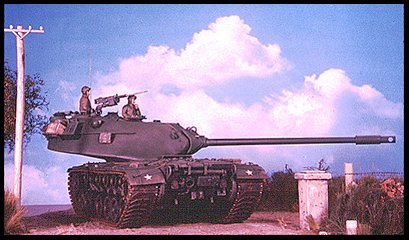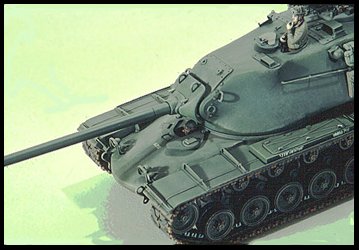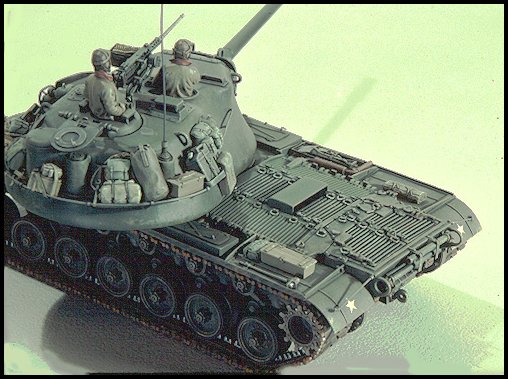

M103A1 Heavy Tank
Daniel Mitchell

The Prototype:
The M103 was the Heavy Tank variant of the M48 series. It was designed as a direct
"counter" to the Soviet's excellent J.S.III
heavy tanks which totally outclassed all other U.S. tanks during the period 1945-1955.
There was a strong "family resemblance" to the M48, enhanced by some components
common to both vehicles. At nearly 65
tons, it was the heaviest tank standardized and actually placed in service by the
U.S.Army. It was also used by the U.S.Marine
Corps.
While the M103's hull had a similar shape to the M48's, it was both longer and wider, and
had thicker armor with better
ballistic shape in the forward hull. The engine "deck" was unlike the M48.
The turret was totally different, with a large bustle to enable the huge 120 mm gun to
recoil. Ballistic shape was excellent from
the front, but poor from the rear. A weird machine gun mount was used to allow the gun to
be trained, elevated, and fired from
within the sealed vehicle.
The suspension was similar to the M48, but modified to carry the increased weight. The
M103 had one additional road wheel
on each side, and, unlike the M48, most of the M103's torsion arms had shock absorbers.
Six return rollers were fitted. The
final-drives were very different, with much larger exposed gear-boxes on the M103.
The model depicts an M103A1, differing slightly from the M103, in having improved
fire-control devices (these resulting in
minor changes in the turret shape).
There was also an M103A2 which was the Heavy Tank variant of the M60 series. It had the
large "bulged" rear engine deck
typical of the diesel engined M48's and M60's. It did see service, a few being
"around" into the 1970's.

The model is largely scratchbuilt.
a) Hull: sheet plastic and Squadron "Green-putty", with portions of two Monogram
M48 hulls where permissible. Note: M103
armor slopes are different than those of the M48, so little "M48" remains
unmodified.
b) Turret: sheet plastic frame and flat surfaces, with LOTS of "Green Putty"
built-up layer after layer, and mostly filed off again,
until the desired shape was obtained.
c) Gun: plastic tube turned to taper on lathe, fitted with internal metal tube for
stiffness.
d) Gun Mantlet: laminated sheet plastic with putty.
e) Engine "deck" (quite different than the M48): "Open" gratings
(louvers) fabricated from strip plastic. Other gratings scribed.
Remaining details fabricated from sheet/strip plastic, and wire.
f) Fenders: Sheet and strip plastic
g) Tool Boxes: Plexiglass, with sheet styrene overlays
h) Muffler & exhaust (for APU): plastic tube and wire
i) Final-Drives: New (and much larger) gearbox housings made from heavy sheet plastic,
detailed with thinner overlays, and
many nut/bolt/washer castings.
j) Hull-rear details and gun "travel-support": fabricated from sheet/rod/tube
and strip plastic, and some wire.
k) Machine Gun Mount (unusual! ... an early attempt to aim & fire the gun from inside
the tank): Misc. plastic and brass parts
l) Shock absorbers: plastic turnings
m) Misc. small details: Sheet, strip and rod plastic, wire, brass turnings

Commercial parts used consist of:
1) Tracks: pieced together (from two Tamiya M48 kits... these are better than the Monogram
tracks)
2) Roadwheels, trailing-arms, and some other suspension components (from two Monogram M48
kits)
3) "Pioneer-tool" rack (Cal-Scale)
4) Machine-Gun (Cal-Scale)
5) Crew Figures (Verlinden)
6) Gas-Cans (Squadron)
7) assorted "luggage" (Verlinden, DAM-Things, various kits)
8) portion of hull-side "blister" (Monogram M48, two kits needed)
9) Nut-Bolt-Washer castings (Grant Line)
Paint:
Model is painted with Floquil paints, and lightly weathered using various washes,
"drybrushing" (with Poly-S earth colors), and
pastel chalks.
Reference:
U. S. Army Tech Manual: TM 9-2350-206-12
Inspection of a prototype M103 at Fort Knox, Kentucky
Inspection of a pre-production version (T43) of the M103 displayed at
TACOM, Detroit
| Main | What's New | Articles | Reviews | Gallery | Think Tank | Contests |